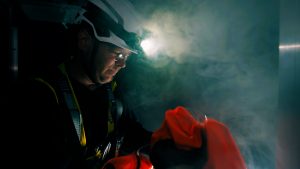Working in a Confined Space: Going in-depth!
Working safely in confined spaces is a critical aspect of workplace safety that often receives insufficient attention. Both employees and employers may not fully comprehend the risks associated with working in or near confined spaces, despite the significant hazards involved.
The Confined space regulations 1997 state: A ‘confined space’ means any place, including any chamber, tank, vat, silo, pit, trench, pipe, sewer, flue, well or other similar space in which, by virtue of its enclosed nature, there arises a reasonably foreseeable specified risk.
What are these Specified Risks?
- Risk of serious injury to any person arising from fire or explosion.
- Loss of consciousness to any person arising from:
- Increase in body temperature or
- loss of consciousness or asphyxiation arising from gas and fumes or vapour, or a lack of oxygen.
- Drowning of any person from an increased level of the liquid.
- Asphyxiation of any person from a free flowing solid or inability to reach respirtable atmosphere.
These Specified Risks may not be present during your initial risk assessment but you may wish to consider: Will the work to be done in the space introduce one or more of these risks? If your answer is YES then you will have a Confined Space.
The Confined Space Regulations and the ACOP L101 help us make the decision if a space is confined or not. If it is, it tells us to put the relevant, suitable, sufficient and reasonably practicable controls in to mitigate any hazards within that space.
This is often done by using further information from the National Occupational Standards (NOS) and by looking at other characteristics of that space for example:
- Ease of access
- Depth
- Natural ventilation
- Rescue considerations
- Likelihood of change
This will then guide us to common classification of Low, Medium and High risk entries. Which can make management of the spaces easier to understand.
Any level of risk can be applied to any space.
Do you need to enter?
Some guidance to help you make a clear decision to enter will come from the Confined Space regs 1997 Reg 4 (1) – No person at work shall enter a confined space to carry out work for any purpose unless it is not reasonably practicable to achieve that purpose without such entry.
Also from the ACOP L101 – ACOP 70 – Duty holders should not enter a confined space and should prevent employees, or others who are to any extent within their control, such as contractors, from entering or working inside a confined space where it is reasonably practicable to thoroughly undertake the work without entering the space.
ACOP 71 – In every situation, the duty holder must consider what measures can be taken to enable the work to be carried out properly without the need to enter the confined space. The measures might involve modifying the confined space itself to avoid the need for entry, or to enable the work to be undertaken from outside the space. In many cases it will involve modifying working practices.
So now you have made a decision to allow such entry. What do you need to know now?
Confined Spaces (Regulation 5) – “No person at work shall enter or carry out work in a confined space unless there have been suitable and sufficient arrangements for the rescue of persons in the event of an emergency.”
Reliance on the emergency services alone will not be sufficient to comply with these regulations. Employers must put in place adequate emergency arrangements before the work commences.
Confined Space Training
Research shows that if you train employees and subcontractors in a timely manner, you increase safety awareness. You also limit the risks and reduce your liability.
By prioritising safety protocols and investing in appropriate equipment and training, organisations can effectively mitigate the hazards associated with working in confined spaces, ensuring the well-being of their workforce. Here at Eurosafe UK, we can help you with all your Confined Space requirements.
















